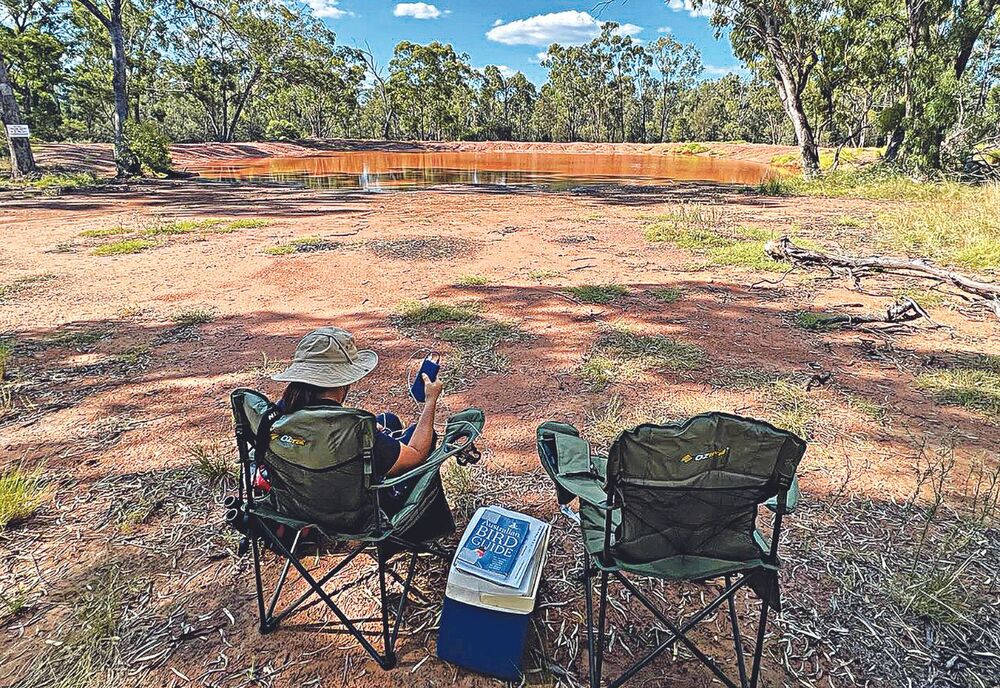Pilliga Glossies are up in the count
Liz Cutts
06 December 2023, 6:40 AM
 A pair of Glossy Black cockatoos drinking at a waterhole. (Photo: John Hansen)
A pair of Glossy Black cockatoos drinking at a waterhole. (Photo: John Hansen)Environmentalists are delighted with the results of a local head count of Glossy Black Cockatoos.
A total of 425 individuals of the vulnerable Glossy Black Cockatoos were observed by more than thirty volunteers stationed at various water points throughout the Pilliga Forests during an official survey held on Saturday, 4 November.
The monitoring project is coordinated by the National Parks and Wildlife Service (NPWS) across the Pilliga Forests and private property every year.
Adam Fawcett, conservation team leader for the Northern Inland says that this year’s count was more than double the number of Glossy Black Cockatoos surveyed in the previous two years.
“Probably, the 510 birds counted in 2019/2020 was a reflection of the intensity of the drought,” Adam said.
“The 2020 and 2022 wet years saw fewer animals coming into the waterpoints, most likely due to the amount of free water in the landscape rather than a decline in the population.”
Watch the water
The survey targets waterpoints such as dams, natural waterholes and bore dams to capitalise on the Glossies coming into drink of an evening before going to roost.
“We have usually been targeting the same waterpoints every year, but this does change depending on access and weather conditions.
“The timing of the count was originally planned to occur in November every year, but during the last two wet years we shifted the survey to February because of flooding.”
Adam says that the annual count also helps gain a good understanding of the number of the species in the Pilliga.
“The count is an important part of the ongoing project ‘Making the Inland Glossy Great Again’,” Adam added.
Volunteers
The project is led by the Central West Local Land Services (LLS) in partnership with NPWS, Department of Planning and Environment, Forests Corporation NSW, Dubbo Field Naturalist and Conservation Society and the Australian Wildlife Conservancy.
It provides a great opportunity for volunteers to be involved in citizen science within the central west.
“We had thirty-three volunteers surveying more than twenty-six waterpoints and contributing 148 hours to this year’s count, which was fantastic support. The survey also gives them the opportunity to see other species coming into drink whilst contributing to a major threatened species management project. Many of our volunteers return every year.”

PHOTO: Volunteers waiting to count Glossy Black Cockatoos at a Pilliga Forest dam. (Photo: Peter Watts)
Know your cockies
Glossy Black Cockatoos are a small brown-black cockatoo with a massive bulbous bill and short crest.
Males have prominent red tail panels and the females yellow to orange-red. Juvenile birds have black bars within the tail panels.
Females also have irregular pale-yellow markings on the head and neck and may have yellow flecks on the underparts and underwing.
The Glossy Black Cockatoo is a specialist feeder and is dependent on the cones of Allocasuarina (she-oak) species which is unique among Australian parrots.
They are typically found in mixed Eucalypt forests and woodlands with significant stands of Allocasuarinas.
They are well known for congregating at waterpoints to drink during the day, including of an evening before going to roost. They nest in large hollow trees.
Continuing the count
“Based on the results of the project to date, the populations look to be generally stable across the Pilliga and surrounding landscape, but numbers fluctuate due to seasonal conditions,” Adam added.
“In good seasons the birds are thought to be more widely dispersed, but this is yet to be fully investigated. During poorer and drier seasons, it appears the birds withdraw to areas with permanent water and food resources.”
The Great Inland Glossy Count is also undertaken annually within the Goonoo and Goobang National Parks and surrounding areas.
As part of the project the Central West LLS has been running workshops and providing seedlings of the feed trees to landholders to encourage habitat creation for the species across the project area.
“This monitoring project is a great example of collaboration across multiple government departments, land managers and volunteers to gain more information on the species to improve ongoing management.”